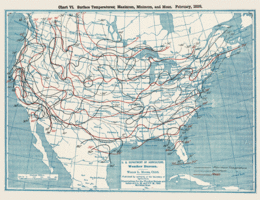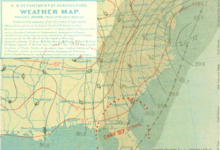Great Blizzard of 1899
 Snowball fight on the steps of the Florida State Capitol in Tallahassee in February 1899
| |
| Type | Winter storm and historic cold wave |
|---|---|
| Formed | February 10, 1899 |
| Dissipated | February 14, 1899 |
| Fatalities | Over 100 deaths |
| Areas affected | United States, particularly east of the Rocky Mountains |
The Great Blizzard of 1899, also known as the Great Arctic Outbreak of 1899 and the St. Valentine's Day Blizzard, was an exceptionally severe winter weather event that affected most of the United States, particularly east of the Rocky Mountains. On February 11, Swift Current in present-day Saskatchewan reported a record-high barometric pressure of 31.42 inches of mercury (1,064 mb). While there was heavy snow during this event, the 1899 storm was most noted for the record cold it brought to several areas of the USA, including the first (and only) below zero (F) temperature ever recorded in Florida (Tallahassee in extreme northwest Florida recorded - 2 F.
Temperatures and records

For the 1895–2017 period of record:
- February 1899 was the second-coldest February in the contiguous U.S. (behind only 1936). The average temperature was 25.50 °F (−3.61 °C), which was 8.36 °F (4.64 °C) colder than the 1895–2017 average of 33.86 °F (1.03 °C) and 0.27 °F (0.15 °C) warmer than February 1936.
- December 1898 through February 1899 was the third-coldest meteorological winter in the contiguous U.S. (behind the coldest and second-coldest winters of 1978/79 and 1935/36, respectively). The average temperature was 27.95 °F (−2.25 °C), which was 4.47 °F (2.48 °C) colder than the 1895–2017 average of 32.42 °F (0.23 °C) and 1.34 °F (0.74 °C) warmer than the 1978/79 winter.
- February 1899 was the coldest February in Kansas, Missouri, and Wyoming.
- February 1899 was the second-coldest February in Arkansas, Colorado, Mississippi, Montana, Nebraska, Oklahoma, and South Dakota.
Winter weather

On February 12, snow flurries were observed in the air (briefly) in a few areas from New Orleans eastward to Tampa. The storm crossed the Florida peninsula with rain and wind, then intensified as it moved rapidly up the east coast. High Point, North Carolina, recorded 10–12 inches (25–30 cm) of snow. Washington, D. C. recorded a single-day snowfall of 20.5 inches (52 cm), which was a record for the time. (On January 28, 1772, 36 inches (91 cm) of snow fell in the Washington area during the "Washington and Jefferson Snowstorm"; however that was before official record-keeping began.)
On February 19, ice floes were reported to be moving out of the Mississippi River into the Gulf of Mexico. On February 14, New Orleans dropped to 6 °F (−14.4 °C), an all-time record. The previous day, the city experienced its coldest-ever Mardi Gras low temperature of 7 °F (−13.9 °C).
The low temperature in Miami, Florida, on February 14 dropped to 29 °F (−1.7 °C) with a high of only 48 °F (9 °C). The city has only recorded a lower temperature twice since record-keeping commenced on September 6, 1895.
The low temperature in Tallahassee, Florida dropped to −2 °F (−19 °C) on February 13, 1899 with a record low maximum of 22 °F (−6 °C) on the 14th. This is the only time in Florida history that sub-zero temperatures have been ever recorded in Florida and these records stand to this day.
Casualties, damages and inconveniences
The Great Arctic Outbreak of 1899 had disastrous impact across many areas of the continental U.S. and Cuba as people, livestock, and wildlife succumbed to the frigid cold.
U.S. bird populations were decimated across the nation. Henderson County, Tennessee saw nearly the complete extinction of its bluebird population and Culpeper County, as well as most northern and central Virginia counties lost nearly all of its quail, having to import new birds in the late teens and 1920s to repopulate the areas.
Some of the bird species affected: Bluebird, Blue-headed vireo, Catbirds, Chipping sparrow, Dark-eyed junco (also known as snowbird), Fox sparrow, Grass finch, Hermit thrush, Killdeer, Meadowlark, Mourning dove, Pine warbler, Quail, Savannah sparrow, Song sparrow, Swamp sparrow, and Woodcock.
It has been estimated that over 100 people died. In Brooklyn, 31 year-old Mary Goodwin was frozen to death and a thinly clad, unidentified woman in The Dalles, Oregon, was found frozen to death in a hallway in an attempt to find warmth. Mail carriers Palmer and Hawkins of New York were thought to have drowned attempting to deliver the mail. It is believed that their boat, overturned by the high winds, was crushed by the floating ice.
Crops were ruined, and orchards were utterly destroyed in Georgia. Walla Walla, Washington's majority of wheat was destroyed by the frost with Eureka Flat seeing the most damage.
Traffic was brought to a complete standstill in all parts of the country. Barges on the Mississippi river, which was in some parts entirely frozen through and the Great Lakes, were brought to a complete standstill. Traffic across all railroads were delayed or paralyzed indefinitely while steamers and liners were likewise delayed.